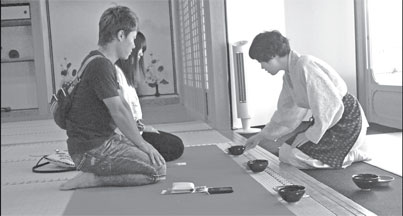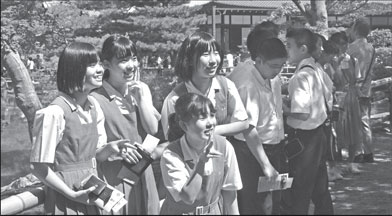 |
|
Golden Pavilion of
Kenkakuji |
Fascinating Kyoto
by Chandani Jayatilleke
Just before we exit the railway station, we stop at the tourism
office to collect a city map and some information about the historical
sites. And an officer there gently asks; “How long are you going to be
in Kyoto?”
We have 36 hours”; I said. He looks at me pathetically and says – “I
reckon there’s nothing much you can do unless it is 36 days.” Anyway he
gives us some leaflets and explains about a few important places.
Alright, we don’t want to spare a second. We navigate our way out and in
a moment we are at the Southern exit of the station.
Finally we are in the historic and bustling city of Kyoto. The
journey from Tokyo by Shinkansen took only two and a half hours.
Well…the ticket was expensive…but it was certainly a hassle free,
enjoyable and comfortable journey – fully worth the money. The bonus on
the way was the marvellous sight of Mt Fuji as we passed the lovely
mountainous countryside. Just before we set off from Tokyo our friend
gave us a hint – to pick a seat on the right side of the train – if we
are lucky, we could catch a glimpse of Mt. Fuji – I yearned for that
moment. We were indeed lucky.
Kyoto is the former imperial capital of Japan and apparently the
seventh largest city of Japan. Visitors to this down-to earth city say
that it is mesmerising.
We were told the best way to visit the city is on foot or by bicycle.
Just across the road we could see many hotel signs and we chose the one
closest to the station for our night’s stay.
From our base we decided to follow the city map and walk along the
scenic canals, serene gardens, bustling streets and explore the city -
by walking into a few temples and shrines of the city’s 2,000 such
places. Soon we realise - yes indeed - it needs perhaps 36 days to cover
all that. It is impossible to see them all in a day or two. We walked
back towards the Kyoto station to get a better view of its futuristic
glass and steel façade.
Modernisation
Kyoto is actually a city rich in history and modernisation.
 |
|
Japanese visitors at
the temple |
We ended our day at a small Japanese restaurant enjoying a Japanese
meal of fish, vegetables and sticky rice and on the way back to the
hotel we savoured the green tea mocha cake which we found only in Kyoto.
The next morning we visited three well-known temples of Kyoto. We
bought the bus tickets from the reception of the hotel and they helped
us find the bus numbers. We hopped on a local bus and headed for the
Kinkaku-ji, the Temple of the Golden Pavilion. We were told that almost
every visitor to Kyoto heads to this temple. History says that
Kinkaku-ji was built in 1398 by the shogun Yoshimitsu as a pleasure home
and he wanted it turned into a temple after his death. However, the
original pavillion had been burned down by a bhikkhu later and the
pavilion visitors see today was built in the 1950s to replace the
original.
Paradise
Kinkaku-ji is a paradise for photographers. The golden reflection of
the pavilion shimmering on the surface of the pond is the main
attraction there. Although the place always gets large crowds of
tourists - and they come by the thousands - the entire area is serene
and calm. The garden expands in a vast area and we took time to relax
and refresh while walking around it. We came across this tiny tea house
– and there we were served tea in the style of a tea ceremony. It was
cold, thick green tea – made with green tea powder. It was very
refreshing indeed.
From there we went to the Sanjusangendo temple famous for its 1001
statues of Kannon. In this temple, in the centre of the main hall sits a
large, wooden statue flanked on each side by 500 statues of human sized
1,000-armed Kannon in 10 rows. It is a sight to behold.
The temple was founded in 1164 and rebuilt a century later after the
original structure had been destroyed in a fire. The temple hall is
Japan's longest wooden structure1 (20 metres). Unfortunately, taking
pictures is prohibited in this hall. We also visited the Ryoan-ji
Temple's dry rock garden. Nobody knows who designed it or what the
meaning is of the 15 rocks scattered across its expanse of raked white
gravel.
Kyoto is a special place; it was spared the bombing of World War II.
Despite the modernisation, the city is still steeped in its past glory.
The people of Kyoto are proud of the UNESCO world heritage sites in
their city. Apart from the cultural sites, the city still has a geisha
district, modern and hip cafes and restaurants. However, our stay in
Kyoto was too short to catch a glimpse of a geisha.
The station is modern, giant and convenient. There are lots of luxury
hotels. But the best experience would be to stay in a traditional
Japanese inn, known as a ryokan. They are popular with tourists; hence
the price is rather high. Kyoto’s duty-free shop of handicrafts is
packed with Japanese crafts from expensive suits of armour, samurai
swords, kimonos and woven bamboo baskets to take home as souvenirs.
 |
 |
| Tea ceremony |
School children
visiting a temple |
|


